#waterpeople
Explore tagged Tumblr posts
Text
According to folklore, using an "artificial" mermaid tail is still considered to be part of a true mermaid.

Edited "Sea Weeds" painting by Arthur Prince Spear, public domain, 1927.
If anyone doubts whether they're a "real" mermaid with just a fabric or a silicone tail, (at least I did when I used to swim with one) it actually could be considered to be a true tail of a mermaid if you look at the good ol' folklore!
Take the fin-wives of the Orcadian finfolk from the Orkney Islands. According to Orknejar, some say their tails were part of their body. Anyhow, others related that their fishtails are said to be a garment that only gathered together to form a tail-like end and that covered the entirety of their legs. On land, a fin-maiden's tail skirt would turn into a "beautiful embroidered petticoat".
Of course, remember the selkies who wore their sealskins in the sea and came on land to take them off.
According to the folk-tale "The-maid-of-the-wave", collected by Donald A. Mackenzie in his "Scottish Wonder Tales from Myth and Legend", the Scottish half-grilse (young salmon) mermaid called maid-of-the-wave, maid-of-the-sea or ceasg also had a large, bright salmon skin covering that she discarded ashore and wore only in the sea again. As it's mentioned in the tale, the maidens-of-the-waves also wore sea-blue garments ashore instead of their salmon skins.
The "Penguin Book of Mermaids" shares the lore of the karukayn, a mermaid from the belief of the Gurindji people in the Northern Territory of Australia. Those freshwater-maidens also have fishtails that they can take off and wear again once they go back into the waters.
According to "Water-beings in Shetlandic Folk-Lore, as remembered by Shetlanders in British Columbia" by James Teit, the mar-folk from the Shetland islands also had fish-like coverings for their legs which they discarded in their homes and when they went ashore.
The most common motif is that a mortal steals a waterperson's skin or hat (as found in the Irish merrows) to return back to the water. Without their skin or whatever they need, they cannot go back to the water, obviously. Mar-folk of the Shetland islands could not travel the seas without their fish-like covering, too. The aforementioned water-wife motif is even present in Australia, far away from Europe. In the legend related in the Penguin Book of Mermaids, a karukayn is taken by a man to be his wife as she had her tail smoked off. Like almost all folk-tales of the selkies etc, the karukayn returned back to the water later on.
Bloop, that shell-tacular lore is shrimply as vast as our oceans...
This only included some of the waterpeople who were capable of removing their tails. Obviously, there happen to be more in the sea.
I had originally published this on reddit via r/mermaid: https://www.reddit.com/r/mermaid/comments/1emp4ay/according_to_folklore_using_an_artificial_mermaid/
49 notes
·
View notes
Text
Americans Have Ruined The Film Industries Of Other Nations
Alright, I've been trying to remain calm but my mood is just ruined by this article I read this morning. You see, the Dutch film industry, because we are a small country, is often reliant on funds or international collabs. Now, this Dutch movie producer has been rejected for these funds twice because his cast is 'too white'. Which is quite offensive because one of the two projects is a historical movie! Whilst there is nothing said in the article about the time period, it's translated title would be 'The Waterpeople of the low lands' . The name water people hints to the Watergeuzen. These were basically freedom fighters back during the 16th and 17th century when our country was ruled by Spain after they invaded us like a century earlier. These were ethnic Dutch and Frisians. In fact, one of the reasons why we have such a respectful relationship with the Frisians (an ethnic minority related to the British who reside in our country and have their own provincial region where they are allowed to have their own cultural practises) is because Frisians were amongst the watergeuzen and fought for our country alongside our ancestors. To this day, anti monarchists are petitioning for our national animal to be a frog instead of the lion, as the lion is the symbol of our monarchy but the frog was the symbol of the Watergeuzen and us as a united people! There were no black people, north Africans or whatsoever walking around in this time period in the Netherlands! The only POC you might find were Asians like the Romani. Our fight for national independence was done by white people. Specifically the ethnic Dutch and Frisians. Are you Americans fucking happy? After attacking European movies and shows for being too white for so long, you managed to corrupt our film industries and people don't want to fund our movies anymore when they have an all white cast- even when it's an historical project during a time period where our history was pretty much exclusively white. We literally aren't allowed to tell our own stories and history, because we are white ethnic groups. We've never made a movie dedicated to these freedom fighters before. The only movie we have of this time period is Kenau and that one wasn't historically accurate but rather playing into the legends surrounding Kenau herself as a feminist symbol. How does it feel, bullying small nations into silence? I can't describe how disgusted I am about the fact this happened. The watergeuzen deserve to have at least one movie dedicated to them. It's not like you Americans care enough about our history that you're making historically accurate movies about our historic figures! Why can't you let us have this?! I'm happy Hollywood is on its deathbed. They and their politics have no right to pressure other nations into following their beliefs.
#tetsutalk#I am so angry#I am enraged#hollywood#movies#history#Dutch history#historical movies#watergeuzen
6 notes
·
View notes
Text
waterspersons aquariums waterpeople oceanariums person festivals beds sets, enbryo parties water tanks beds sets, fetus party water tanks beds sets, babies sites sleep numbered beds sets, teenagers ssites sleep numbered beds sets, 18 years old sssites numbered beds sets, adults ssssites numbered beds sets earth must return to earth. on. paid. blood on paid. vvoiced paid. mail kiy key card dh to candace marie hughes. on. paid. vvoiced paid. whooping areas thoughts screenedbeds beddings sets must return to earth. on. paid. blood on paid. mail kiy key card dh to candace marie hughes. on. paid. vvoiced paid.
0 notes
Text
Crisp Creek
October 13, 2022
please let the creek take over me. and the weeds.
I want to feel the dewy grass against my bare feet.
I want to step in the puddles of the cold, crisp water of the creek.
I’ll make patterns in the water.
I’ll hold a mirror up to these waves and project them into me.
I want to experience earth. natural. I just want to feel something real in its existence.
I need to feel alive again. I need to be free. I feel I am stuck in this bubble absorbing meaningless media & the things I yearn for. but I just don’t put in the effort to experience them.
I feel time is running out. I need to do this and that because it’s fall, and the leaves of all the trees are red and orange. I just can’t seem to grasp the fact that time is finite. and the leaves will be green again soon. I do love winter, it’s just not the same.
but I want to wear that white dress that’s see-through in the sun. I want to wade in the cold creek. I want to live this life I fantasize. here’s my description:
“a sunny day with the bugs and little critters next to the stream; sunlight streaming thru the trees and a white blouse, jewelry staining your skin green, the air is fresh… the water crisp…”
this is what I need. it would cleanse my body and soul; renewing me. I just need nature to swallow me whole. the flowers to consume me; whilst I become one with the earth. I want to lay down in a forest and fall asleep forever. to never awake.
I believe all my worries would disappear. the plants and vines will engrave their roots into my brain, so I won’t think about anything else at all ever. moss would fasten to my skeleton. I would deteriorate. there would be nothing else left but the crisp creek and dewy grass in it’s existence all by itself in a world not so small as I’d imagined it to be.
-oomingmak
9 notes
·
View notes
Text
Similarities of Folklore in H2O: Just Add Water
Previously I did a post on Cleo's bathtub transformation and how it's a previous motif in some legends. I now want to dive into the rest of the folklore that can be fished out of the show. Many parallels are not directly the same, but still share some interesting origins. First, let's look at the powers.
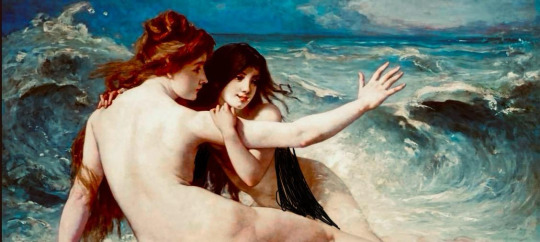
Edited and cropped "Sous la Vague" or "Les Baigneuses" by Nicolas Auguste Laurens in 1898.
1: Cleo's hydrokinesis can be found in many waterpeople. Almost all humanoid water deities across the world are able to bend water to some extent, many of would would be countless to name in one post. For instance, Poseidon/Neptune was said to be able to control the seas. Triton could calm and raise the waves of the sea with the blow of his conch shell. Aside from water deities themselves, other waterpeople were able to control water. According to "Scaled for Success: The Internationalisation of the Mermaid" on page 108, the Filipino sirenas were said to be able to control water "by manipulating water levels and/or create whirlpools to swamp their prey". According to "Mermaids: The Myths, Legends, and Lore" on page 180, the Filipino kataws control the waters around the Philippine Islands, namely its "tides, currents" and even the "movements of the aquatic creatures". The Asturian xanas were in charge of keeping rivers and fountains calm according to: Mitología Asturiana - Marsellaviana on Freehostia under the llavanderes or washerwomen entry http://marsellaviana.freehostia.com/mitologiaasturiana/seresmitologicos.html
One xana in particular was able to flood as she supposedly flooded the town of Gayangos and created an entire lagoon and the lakes in the area according to: La leyenda de la Xana de Gayangos - La Cantabria Burgalesa https://lacantabriaburgalesa.wordpress.com/2016/12/03/la-leyenda-de-la-xana-de-gayangos/
Asturian llavanderes, basically mythical washerwomen, were able to summon floods and create whirlpools according to the aforementioned Marsellaviana site.
Another mermaid is the seewief or seewiefken of German folklore in Minsen. She once got caught in the net of some fishermen and got tormented, yet she eventually escaped. In revenge, she cast a curse and created storm floods in the years of 1164, 1362, 1717 and 1962 that hit Minsen. This is told according to: The Minsen Mermaid Statue - a Seewief from the Middle Ages https://mermaidsofearth.com/mermaid-statues-mermaid-sculptures/public/minsen-mermaid-statue-seewief/ (This sourced some other sites, but they are gone), Die Sage from Minsener Seewiefken - NAKUK https://www.nakuk.de/wiki/seewiefken/, Seewiefken - Wangerland https://www.wangerland.de/poi/seewiefken and Das Minsener Seewiefken Vom Fluch der Meerjungfrau - NWZ Online https://www.nwzonline.de/kultur/minsen-das-minsener-seewiefken-vom-fluch-einer-meerjungfrau_a_50,6,796560382.html
Yet another is the zeemermann of the Saeftinghe legend in the Netherlands. A zeemermin once got caught by a fisherman who refused to let her go. Her husband swam after the boat, yet to no avail. He cursed Saeftinghe and flooded the land. It was said that only Saeftinghe's towers would remain. Now, the land, it's called the drowned land of Saeftinghe. This is told according to "The Mermaid Atlas - Merfolk of the World" by Anna Claybourne on page 31 and Wandelen in het verdronken land van Seaftinghe - JNM https://jnm.be/nl/activiteiten/wandelen-in-het-verdronken-land-van-seaftinghe
~~~
2: Rikki's fire power: Waterpeople can be associated with fire, the sun or warmth despite inhabiting the water. (Added note: Originally, I did not acknowledge that). In Thai folklore exists the so-called Phi thale ผีทะเล sea spirit who is able to appear as a mermaid or a beautiful woman who can lure sailors to their demise. Sometimes a Phi Thale takes form as a St. Elmo's fire, basically a weather phenomenon caused by electrical discharges during thunderstorms. It seems to appear like faint luminosity or "fire" and in context of the Phi Thale it might, for example, take place on a ship's mast as shown on the illustration, but one is not absolutely shore. St. Elmo's fire also appears in many other forms like on church towers. Phi Thale description is from: What is a Phi Thale (ผีทะเล)? - PAHUYUTH https://pahuyuth.com/en/glossar/phi-thale/ and information on the Saint Elmo's Fire - Britannica https://www.britannica.com/science/Saint-Elmos-fire
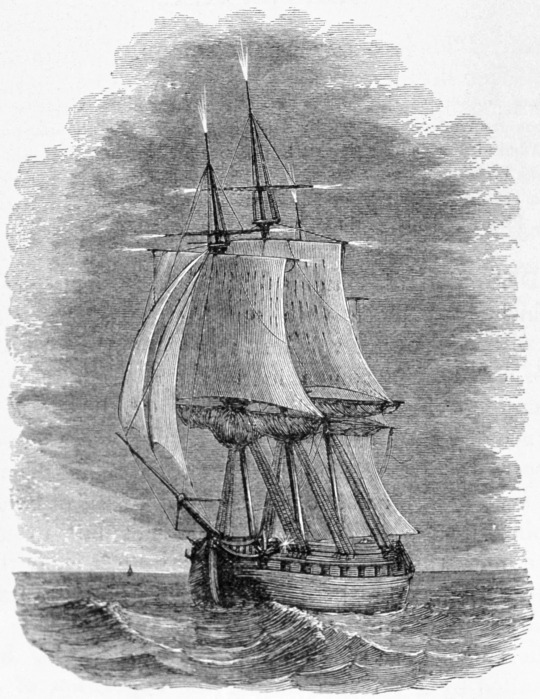
Illustration from "The Aerial World" by Dr. G. Hartwig in 1886 on page 310.
Sulis is a Celtic water goddess from the United Kingdom who is still associated with the sun and is thus both a water and solar deity. She was also associated with the hot springs in Bath according to Sulis, Goddess of Celtic Mythology | Characteristics & Depictions - Study. com https://study.com/academy/lesson/sulis-celtic-goddess-mythology-history.html?srsltid=AfmBOopQslCH2QEArMfaq5VE7QDgXuMQS3z55jnppUGbVGlpA3E7ldu2.
The lakes of the Catalan freshwater-maidens called the dones d'aigua were said to boil if a stranger would dive into them, yet this is only said on Wikipedia without a source and until I do not have found any good source for this, please do not claim it as fact.
The Portuguese water-maiden Maria da Manta meaning "Mary of the Blanket", Maria Gancha namely "Mary Hook", Maria Ganta meaning "Mary of the Grid" or as in the Miranese language, Mariamanta, was said to live in wells. While her appearance varied a lot, some would say she possessed eyes made of fire despite living in the waters of wells according to: Maria Gancha - Portuguese Creatures and Legends Galore https://portuguesecreaturesandlegendsgalore.wordpress.com/2020/02/14/maria-gancha/
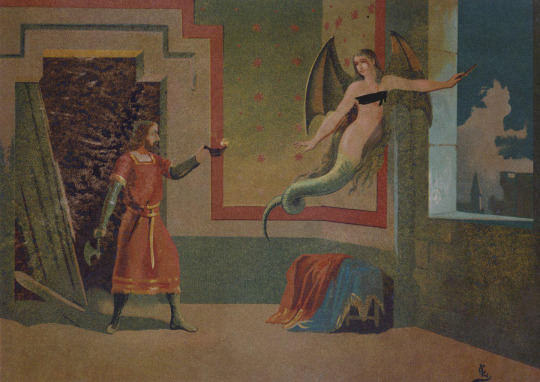
Illustration for "Las Supersticiones De La Humanidad" by Jose Coroleu in 1881.
Melusine from French folklore is sometimes said to grow wings when she flies away in the legend and therefore is sometimes considered to be a literal dragon-maiden either with one or two fishtails and sometimes only with a serpent tail depending on the version. She is both considered a watermaid and a dragon-maid in different versions because of that.
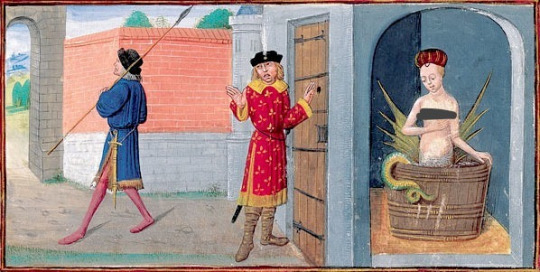
Illustration from "Le Roman de Mélusine" in ca. 1450-1500.
An enchanted xana could also turn into a cuélebre, namely a snake-like dragon, in order to be disenchanted. Her savior must perform some tasks so that she would be able to be free from her spell, turn back into a xana or a normal human being and be freed from being bound to her lair. This disenchantment is really complex and one can find a wide sea of different methods. One source of mine is: Some thoughts on Asturian Mythology - David A. Wacks https://davidwacks.uoregon.edu/2014/12/12/asturian/. In spite of that, both of these dragon-turned watermaids didn't emit fire from their mouths. I still included them because it shares a little of the fire aspect due to their dragon forms.
~~~
3: Emma's ice power: Plenty of waterpeople live in colder waters, but do not possess the power to manipulate water and turn it into ice. The only mention one ever heard of are the Filipino kataws who can also turn water into ice according to this Wikipedia article https://en.wikipedia.org/wiki/Kataw_(Philippine_mythology) that sourced "Mga Engkanto: A Bestiary of Filipino Fairies. Philippines: eLf ideas Publication. 2003". It's probably a privately published book as I can only find a Blogspot post about its concept idea. Would like to confirm the source, but as of now one does not have the book.
~~~
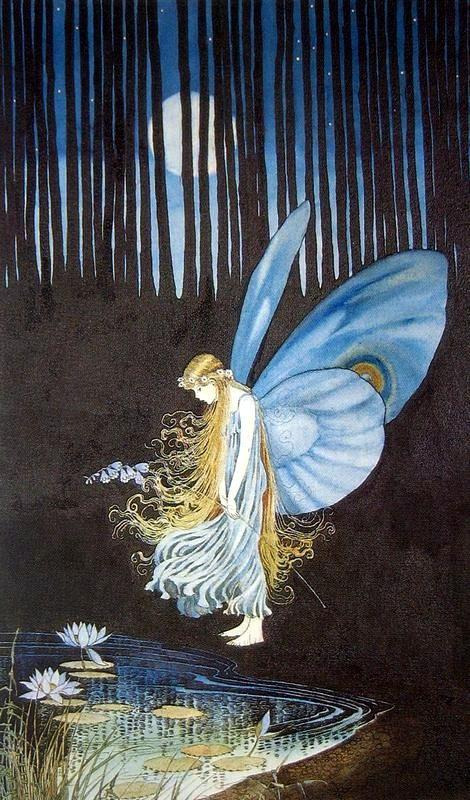
"The Last of the Fairies" by Ida Rentoul Outhwaite (1888-1960)
4: Simply the moon or the full moon: Waterfolk has a relationship to the full moon. There is no moon pool or a direct moon spell affecting waterfolk, yet Catalan dones d'aigua tended to only show up on full moon nights where they would come out of their caves to dance, to comb their hair and to wash their laundry. Some would only sing on full or new moon nights, maybe they got spell-bound by the moon? Who knows. This is told according to: Les dones d'aigua - Elisenda Vilaró Móra http://www.elisendavilaromora.com/2012/03/les-dones-daigua/, Llegendes del riu i les done's d'aigua - Turisme Les Planes D'Hostoles https://turismelesplanes.cat/localitzacions/el-riu-i-les-dones-daigua/, Llegendes: Dona D'Aigua - Generalitat de Catalunya Departament d'Educació https://agora.xtec.cat/ceipcamins/4t/llegendes-dona-daigua/, Llegenda de les Dones d'Aigua - Mapes de Patrimoni Cultural https://patrimonicultural.diba.cat/element/llegenda-de-les-dones-daigua, Les dones d'aigua en la tradició popular - Mitologia Catalana Blogspot https://mitologiacatalans.blogspot.com/2016/09/les-dones-daigua-en-la-tradicio-popular_23.html and Mitologia Catalana - Isaac Baley https://www.isaacbaley.com/mitologia-catalana.html
One xana was said to be only present on full moon nights, dancing in the forest. This is said according to: La leyenda de La Xana: una historia de amor en Asturias - Crónica Asturias https://cronicaasturias.es/blog/la-leyenda-de-la-xana-una-historia-de-amor-en-asturias
Atargatis is one of the earliest waterfolk deities aside from the kullulû of Mesopotamia. She's an Assyrian fertility and mermaid goddess, yet was also described to be a moon goddess according to "Mermaids: The Myths, Legends, and Lore" on page 78.
The selkies were also said to go ashore on full moon-lit nights to shed their sealskins and dance at the seaside.
~~~
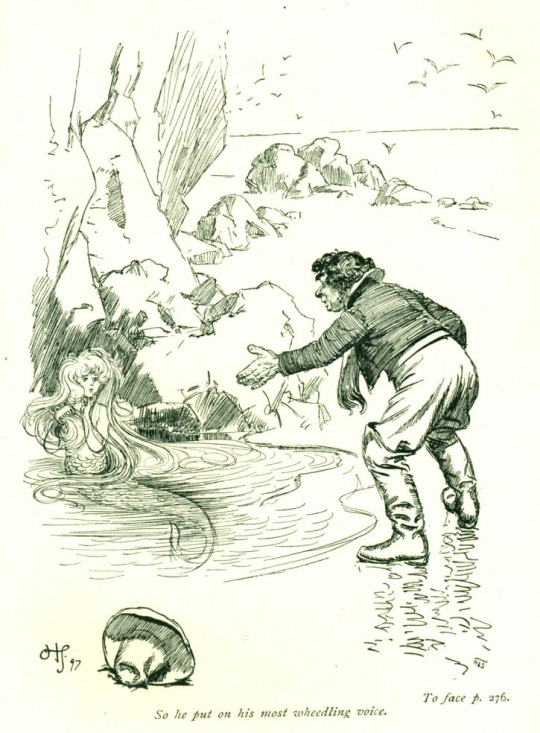
Illustration by Hugh Thomson for "Highways and Byways in Devon and Cornwall" in 1897.
5: The granting wishes ability from episode 5 "Hocus Pocus" on season 2: In the Cornish legend of Lutey Curry and the merry-maid, the merry-maid was said to have given Lutey three wishes as he had helped her go back into the water from being beached ashore. He wished for the power to heal the sick, the power to "defuse wicked spells" and to have his powers passed on after his death according to "Mermaids: The Myths, Legends, and Lore" on page 102 and Curses, Vengeance, and Fishtails: The Cornish Mermaid in Perspective https://www.academia.edu/31865439/Curses_Vengeance_and_Fishtails_The_Cornish_Mermaid_in_Perspective
The Scottish ceasg or maid-of-the-wave was also said to grant one three wishes if one caught her and then released her again according to #FolkloreThursday: The Ceasg - Steampunklibrarian Blog https://steampunklibrarian.blog/2021/09/30/folklorethursday-the-ceasg/ and Gaelic Folklore (5): Ceasg - Nicovleeuwen https://nicovleeuwen.blogspot.com/2019/06/gaelic-folklore-5-ceasg_7.html
~~~
6: The shapeshifting from mermaid to human is something prevalent in folklore, but not at the simple touch of a water drop. Instead, primarily only if the lower half is fully submerged, basically when fully going into a water body. Most waterfolk only have a fishtail that they can discard and wear later on again like a piece of clothing, but some do fully shapeshift like the mermaids of the show do. According to "Mermaids: The Myths, Legends and Lore" on page 181, the fishtailed yawkyawks from the mythology of the Kuninjku people in Australia could go ashore and "sprout legs and seem to be wholly human".
~~~
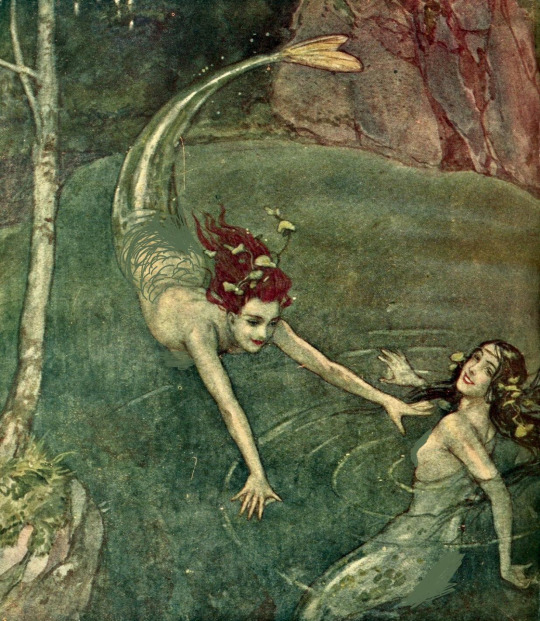
Edited “Unter-Wasser-Philosophie” by Erich Schütz for Mocca in 1934. Yawkyawks were said to have green hair resembling green algae in freshwater streams and rock pools, called man-bak in Kuninjku according to Yawkyawk (Ngalkunburriyaymi) - Maningrida Arts and Culture https://maningrida.com/artwork/683-23/.
As the show is set in Australia, the waterfolk of Australia is another part to consider. Here's a list of the Indigenous Australian watermaid ones. I won't skim through the entirety of their lore due to the fact that there are barely any parallels between them and the show, aside from the yawkyawks who could shapeshift into humans:
< Yawkyawks (other terms: ngalkunburriyaymi, ngalberddjenj (both possibly from the Kuninjku people) ngalworreworre (Wugularr community) from the book "Mermaid and Serpent - A Story from Wugularr Community", and ngalkodjek (Darnkolo people) as from: Owen Yalandja: Ngalkodjek Yawkyawk 2019 - ARTKELCH - Contemporary Aboriginal Art https://www.artkelch.de/en/artists/owen_yalandja_216/works/ngalkodjek_yawkyawk_1827
< The pearl-givers or the mermaids of the Keppel Islands of the Woppaburra people are found in "Among the Mermaids: Facts, Myths, and Enchantments from the Sirens of the Sea" on pages 98-99.
< The Ji-merdiwa from the Burarra people near the Blyth river can be found on: Mermaids tales appear in myths across the world- Arnhem Land included by Anna Whitfeld - ABC News https://www.abc.net.au/news/2018-06-11/mermaids-across-the-world-arnhem-land/9846210
< Wíwa spirits (mermaid spirits) from the Kunibídji people and Djómi and Bábbarra, and the other successor Djómi spirits: Our Bedtime Stories Episode 8: Djómi (Mermaid Story) - ICTV Play https://ictv.com.au/video/item/5508?lp=1, Djomi ( Fresh Water Spirit) Bábbarra Women's Centre https://babbarra.com/design/djomi/
< The karukayn of the Gurindji people as told in “The Penguin Book of Mermaids” on pages 224-225
< and the Muli Kanybubi from the Marri Ngarr Yek Dirrangara people as told in “Muli Kanybubi Tjitjuk Kawuny Na Yagatiya - The Two Mermaids’ Dreaming Place”.
More resources on the Indigenous Australian watermaids: Mermaids in Folklore & Australian Indigenous Culture - troublemag https://www.troublemag.com/mermaids-in-folklore-australian-indigenous-culture/ and H2O: Just Add Water and myth of mermaids in Australia - Anglophone Literatures Blog https://blogs.phil.hhu.de/anglophoneliteratures/2022/04/04/h2o-just-add-water-and-myth-of-mermaids-in-australia/
Whether intentional or not, the lore is pretty deep.
(If any sources are not able to be viewed, consult an archival site)
Re-published and re-polished from the edited original entry on reddit via r/JustAddWater: https://www.reddit.com/r/JustAddWater/comments/1f934vx/similarities_of_folklore_in_the_show/
In the original entry, I had wanted to include these depictions that can be seen here, but it got removed. I am not shore what the culprit was, but it may have been the second or latter depiction of Melusine as I did not edit it back then since I thought it would be tolerated because no chest was directly visible. On the un-edited version of the depiction, her chest was already obscured by a light spot that looks like as if the paper had been ripped.
#mermaid#mermaids#folklore#waterfolkology#h2o just add water#h2o mermaid#h2o#cleo sertori#rikki h2o#rikki chadwick#emma h2o#cleo h2o#emma gilbert
38 notes
·
View notes
Photo

Water person with her water pets 🐚🧜🏽♀️🐬🐳🌊🐠 :: #aquafarians #waterpeople #digitalart #digitalillustration #digitaldrawing #digitalpainting #Art #Blue #MerMay #mermay2021 #WaterDog #wateranimals #water https://www.instagram.com/p/CO-3rh2FEB6/?igshid=1ru36inocfzky
#aquafarians#waterpeople#digitalart#digitalillustration#digitaldrawing#digitalpainting#art#blue#mermay#mermay2021#waterdog#wateranimals#water
1 note
·
View note
Photo

Reposted from @vitadasirena (@get_regrann) - She had a galaxy in her eyes... A universe in her mind 🌠 Shot by @suahuatica 📸 for @cressimalta 💦 . . . . . #portraits #galaxy #universe #divemask #mask #cressi #cressi1946 #cressisub #bestfreedivegear #paradisebay #brunettegirls #padifreediver #waterpeople #pixelart #pixel #underwaterselfie #underwaterphotographygraphy #eyecontact #sonyimages #photoshoot #photographylover #lookatme #insta_daily #insta_love #insta_art #insta_fun #portraitphotography #portrait_vision https://www.instagram.com/p/B2-ButAFuM7/?igshid=1wd3fdpkmghuf
#portraits#galaxy#universe#divemask#mask#cressi#cressi1946#cressisub#bestfreedivegear#paradisebay#brunettegirls#padifreediver#waterpeople#pixelart#pixel#underwaterselfie#underwaterphotographygraphy#eyecontact#sonyimages#photoshoot#photographylover#lookatme#insta_daily#insta_love#insta_art#insta_fun#portraitphotography#portrait_vision
6 notes
·
View notes
Text
Waterpeople are rather omnivorous according to folklore and sightings, but the accounts of them consuming flesh are more frequent. The statement mostly seems to come from a point of view where one got hooked by media that tend to change the previous, darker takes on waterfolk in order to make them more tolerable, yet I am not shore?

"A Very Handsome Mermaid" by Walter Satterlee for "Elfin Land" in 1882.
One of the earliest water-maidens recorded from mythology named Atargatis was said to have been turned into a fish waist-down after plunging into a lake. She represented the Assyrian superstition to refrain from eating fish. Greek poets had primarily reported of her. Certain species of fish were deemed as being sacred to her and such sacred fish could be found in lakes or ponds at temples dedicated to her. Her worshipers were forbidden to eat fish and they believed that if they ate the "sacred flesh", they would get ulcers. Anyhow, it was said that fish could still be offered upon Atargatis despite her devotees being "legally banned" from eating fish. When her devotees prayed to her, they made offerings of fish made of silver or gold, for example. Fish could also get presented upon the deity daily, "attractively prepared and served". Atargatis was said to like to eat the fish herself. What is very finteresting is that the priests of hers would eat the fish themselves subsequently after being offered to Atargatis. Supposedly, it was a "controlled sacred act". According to the third source listed, those fish were mystic meals in which priests and initiates consumed the "forbidden food in the belief that they were absorbing the flesh of the divinity herself". Sources: The Encyclopaedia Britannica: Andros-Austria on page 823 https://books.google.de/books?id=BtgO7ompq40C&pg=PA823&dq=atargatis+forbidden+fish+britannica&hl=de&newbks=1&newbks_redir=0&sa=X&ved=2ahUKEwj8nL7Vtc-JAxWGBzQIHbpWARAQ6AF6BAgFEAI#v=onepage&q=atargatis%20forbidden%20fish%20britannica&f=false, Religion of the Semites: The Fundamental Institutions by William Smith https://books.google.de/books?id=d8s3DwAAQBAJ&pg=PT225&dq=atargatis+forbidden+fish&hl=de&newbks=1&newbks_redir=0&sa=X&ved=2ahUKEwie0paBt8-JAxVDADQIHSbtNjAQ6AF6BAgHEAI#v=onepage&q=atargatis%20forbidden%20fish&f=false and Eat Not This Flesh: Food Avoidances from Prehistory to Present by Frederick J. Simoons on pages 269-270 https://books.google.de/books?id=JwGZTQunH00C&pg=PA270&dq=atargatis+presented+fish+priest&hl=de&newbks=1&newbks_redir=0&sa=X&ved=2ahUKEwi428XnzNGJAxUDHzQIHSZxLDoQ6AF6BAgFEAI#v=onepage&q=atargatis%20presented%20fish%20priest&f=false

Edited "The Sea Maiden" by Edward Burne-Jones in 1881.
The margygr from Greenland as mentioned in The King's Mirror would wield a fish which she would either eat, throw away or at a ship. If she threw it at a ship, a storm was said to brew, yet otherwise not. Source: The hafstramb and margygr of the King’s Mirror: an analysis by Waldemar H. Lehn and Irmgard I. Shroeder in the Polard Record on pages 121-122.
The Orcadian sea-trows would also steal the fish from the hooks of fishing mortals in order to devour those fish. The second source nicely summarizes the sea-trows as being "Too lazy to catch fish for himself, the Sea Trow would often lie at the bottom of the sea, watching the fishermen's lines. If a fish was caught on the hook, the Trow would unhook the fish, conveying it to his own capacious mouth. Where there was no fish, the Trow would satisfy his hunger by gently removing the bait from the hook. But this was a dangerous prank ; for the Trow was sometimes hooked, and drawn up to the surface". Sources: The Sea Trow - Orkneyjar https://web.archive.org/web/20050204133006/http://www.orkneyjar.com/folklore/strow.htm and Northern Notes and Queries or The Scottish Antiquary on page 180 https://archive.org/details/scottishantiqua05unkngoog/page/n180/mode/2up?view=theater
Another example comes from a sighting in 1812 at Exmouth. Mr. Toupin and his crew heard a strange noise like "the wild melodies of the Aeolian harp combined with a noise similar to that made by a stream of water falling gently on the leaves of a tree" and sighted a seal-like mermaid. One of the boatmen threw a piece of boiled fish at it which he had previously stored in his locker. "This seemed to alarm the animal, though it soon recovered from its fears, for we presently observed it to lay hold of the fish, which it ate with apparent relish". Sources: Mr. Toupin's Mermaid - Wayland Wordsmith https://waylandwordsmith.blogspot.com/2010/01/mr-toupins-mermaid.html and Mermaid at Exmouth eats Boiled Fish - Beachcominb's Bizarre History Blog https://www.strangehistory.net/2011/09/29/mermaid-at-exmouth-eats-boiled-fish/
Some waterpeople also eat goods similar to ours.

"A la Recherche du Temps" by Charles Amable Lenoir (1860-1926). I am aware that she is holding a book, but it looks like a square-shaped cheese to me.
The diet of the Basque laminak primarily consisted of dairy meals. Many tended to drink milk. They liked curd, cheese, and cuajada, which was a set yogurt made from the milk of sheep. Others ate meat including bacon, ham, and salt pork. Some even ate leftovers such as those from fats meanwhile some even consumed grease. Laminak also ate leftovers from stew and flour. Others ate bread and some drank cider even. Sources: Alimentos - Lamia - Auñamendi Eusko Entziklopedia 1981 version https://aunamendi.eusko-ikaskuntza.eus/es/lamia/ar-84676-151286/be-1/, Lamia - Hiru https://www.hiru.eus/es/cultura-vasca/lamia, Basque Gender Studies | Margaret Bullen - Academia.edu on pages 145-148 https://www.academia.edu/3357561/Basque_Gender_Studies, They Shimmer Within: Cognitive-Evolutionary Perspectives on Visionary Beings by Bruce Rimell on pages 45-46 https://books.google.de/books?id=DelHDwAAQBAJ&pg=PA46&dq=lamia+basque&hl=de&newbks=1&newbks_redir=0&sa=X&ved=2ahUKEwiBs66Y_-SDAxUExQIHHXnfDVMQ6AF6BAgEEAI#v=onepage&q=lamia%20basque&f=false, Selected Writings of José Miguel de Barandiarán: Basque Prehistory and Ethnography - Center for Basque Studies on page 128 https://web.archive.org/web/20221006235412/https://scholarworks.unr.edu/handle/11714/750 and Second Edition: Basque Legends by Wentworth Webster - Project Gutenberg on pages 55-57 https://www.gutenberg.org/files/34902/34902-h/34902-h.htm#ch4.3
The Orcadian finfolk were said to extract milk from whales which they herded in their aquatic winter hibernation realm beneath the ocean waves called the Finfolkaheem. Anyhow, they had also been described as being sea predators. Finfolk, "mounted on their aquatic steeds, would often hunt the animals of the sea using otters in place of dogs". Source: Finfolkaheem - Orkneyjar https://web.archive.org/web/20080827100804/http://www.orkneyjar.com/folklore/finfolk/heem.htm
Waterfolk could still be people-eaters. The further descriptions may be somewhat disturbing.
Murdúchanns from Irish folklore were said to swim about in the Ictian Sea, present-day English Channel, and sing siren-like songs to lull their mortal victims into a slumber in order to make them fall off their vessel and devour them. Roth Mac Cithang, the prince of the strong and legendary Fomorians who had once invaded Ireland, was one of their victims. He heard their song and they feasted on him as soon as he lost his consciousness. They would separate his body by his joints. It was said that one of his enormous thigh bones had supposedly washed up at the town of Waterford. It was so large that "the drink of a hundred men would fit in the hollow of the bone" as mentioned in the first source. This is horrific that even mighty, feared mortals could get defeated by such dangerous waterfolk. Waterford is therefore also referred to as "Port Láirge" in the Irish language, meaning "The Port of the Thigh". Sources: Mermaids, Merrows, and Selkies - Unreal Podcast https://unrealpodcast.com/mermaids-merrows-and-selkies-podcast-script/, Revue Celtique on pages 433-434 https://books.google.de/books?id=BVM7AQAAMAAJ&pg=PA432&redir_esc=y#v=onepage&q=thigh&f=false

"La Sirena" by Freiherrn von Habermann (1849-1829).
The English freshwater-maidens such as Peg Powler and Jenny Greenteeth had been said to drown mortal victims in their freshwaters to devour them. They possessed a strong thirst for mortal humans. Source: Strange and Secret Peoples: Fairies and Victorian Consciousness by Carole G. Silver on pages 155-156 https://books.google.de/books?id=SRtREAAAQBAJ&pg=PT171&dq=jenny+greenteeth+devour&hl=de&newbks=1&newbks_redir=0&sa=X&ved=2ahUKEwjNwsfjh9KJAxV3wAIHHXitO-AQ6AF6BAgNEAI#v=onepage&q=jenny%20greenteeth%20devour&f=false
Yannig an Od of Breton folklore was a little sea-man lurking at the shores of the Breton coast, calling out like a seabird three times. If one did not hide upon his third call, he would eat his victim. Source: The Encyclopedia of Celtic Mythology and Folklore by Patricia Morgan on page 476 https://books.google.de/books?id=nd9R6GQBB_0C&pg=PA476&dq=yannig+folklore&hl=de&newbks=1&newbks_redir=0&sa=X&ved=2ahUKEwjx_srBotKJAxWs4QIHHWIwETgQ6AF6BAgEEAI#v=onepage&q=yannig%20folklore&f=false
Last but not least, the waterhorse-people like the Scottish kelpies who could shapeshift into humanoid forms commonly ate mortal victims. For instance, the kelpie would lure their victim to drown with its humanoid or equine form to devour one except for one's heart and liver, yet this depends and many versions exist. Basic resource: Monster Monday: Kelpie - Write Wrote Written https://writewrotewritten.wordpress.com/2014/03/31/monster-monday-kelpie/
(If any source is not able to be viewed, try to consult an archival site)
Thanks for diving into this :>
"Ohhh, mermaids don't eat fish because that's cannibalism!!1! Fish are friends not food 💕💕💕 All mermaids are vegetarian ✨🩵✨🩵"

134 notes
·
View notes
Photo
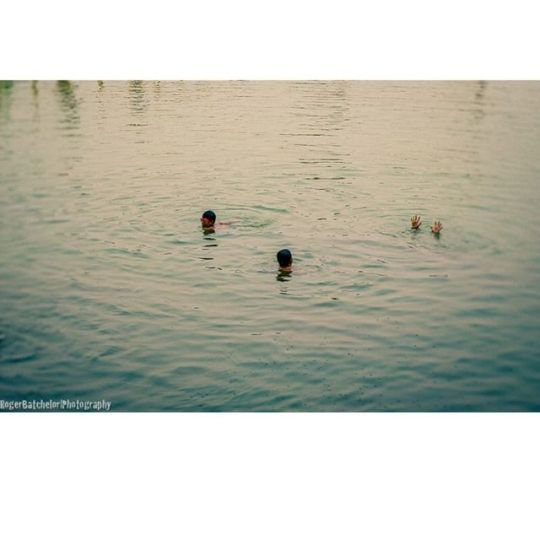
#headshots #heads #waterpeople #cambodia_shots #travel #natgeo_lovers #natgeo #condenast @joebiden @condenast @condenasttraveller #travelss #RogerBatchelorPhotography.com https://www.instagram.com/p/B2IQNDmhlaS/?igshid=1wmbpx4cd9yn
#headshots#heads#waterpeople#cambodia_shots#travel#natgeo_lovers#natgeo#condenast#travelss#rogerbatchelorphotography
2 notes
·
View notes
Photo
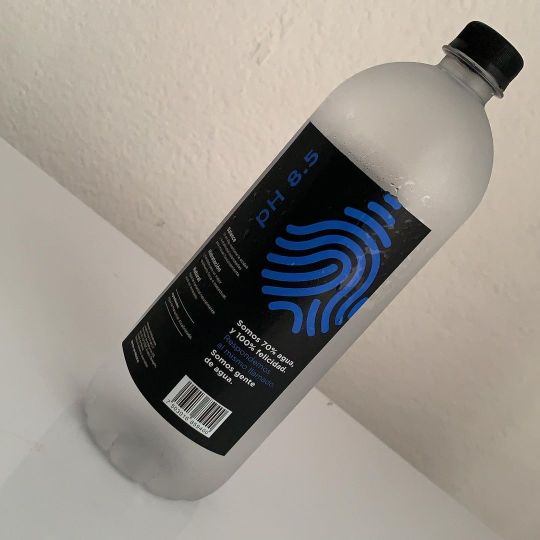
Vamos a probar esta agua a ver qué tal, dicen dicen que te da mucho flou !!! Que no @jucaviapri #waterpeople (en Cancún, Quintana Roo) https://www.instagram.com/p/CQUZbyyJXUK/?utm_medium=tumblr
0 notes
Photo
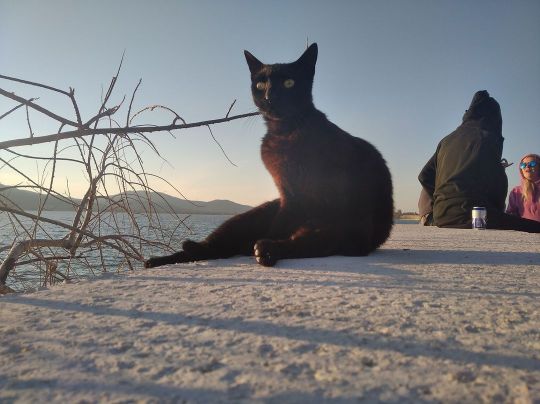
Saying WHAT??!!⠀ .⠀ .⠀ .⠀ .⠀ .⠀ .⠀ #waterworld #aroundtheworld #travel #waterplanet #ocean #sea #waterpeople #diving #floating #freedom ⠀ #pirates #alternative #lifestyle #selfsustainable #sailors #sailboat #sailcouple #cattain #sailorcat #blackcat #catsofinstagram #metalheads #sailorcouple #mutineers #sailorcat #liveaboards #sailboat #sailinstagram #sailing #boatlife (at Pálairos, Aitolia Kai Akarnania, Greece) https://www.instagram.com/p/CNEoDKmA7W6/?igshid=1or2s3lx3uvmu
#waterworld#aroundtheworld#travel#waterplanet#ocean#sea#waterpeople#diving#floating#freedom#pirates#alternative#lifestyle#selfsustainable#sailors#sailboat#sailcouple#cattain#sailorcat#blackcat#catsofinstagram#metalheads#sailorcouple#mutineers#liveaboards#sailinstagram#sailing#boatlife
0 notes
Photo
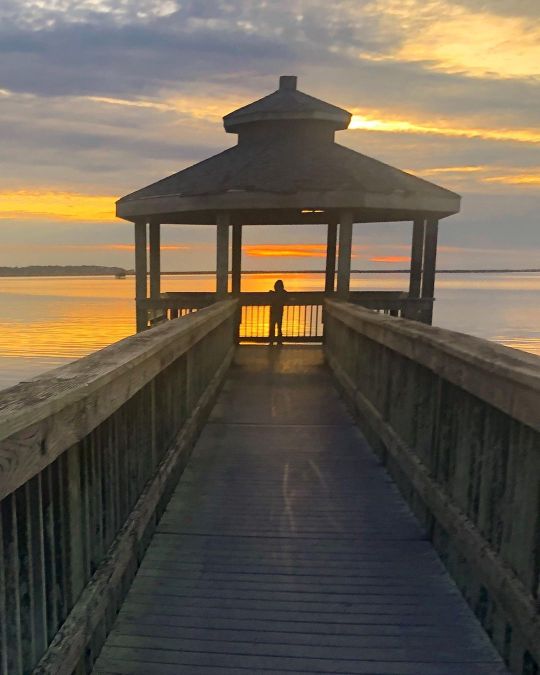
Life is good. ✨🌅✨ #sunsetsofinstagram #oldfriends #waterpeople #obx (at Kitty Hawk, North Carolina) https://www.instagram.com/p/CKt8RTzF8En/?igshid=16nil0x3rvgmq
0 notes
Text
FIT Monólogos
International Online Festival of Latin Theater. Actor’s powerful force to move people. July 24-31, 2020 https://waterpeople.org #fitmonologos #waterpeople
To purchase tickets
https://waterpeople.org/box-office/
* $3 per monologue
* All Access pass $30
* Humanitarian All Access pass $40
Opening Night Friday July 24, 2020 6 pm CDT / 7 pm. EDT
FIT MONÓLOGOS CEREMONIA DE INAUGURACIÓN
Closing Night Friday, July 31, 2020 6pm CDT / 7pm EDT
CEREMONIA DE PREMIACIÓN
https://waterpeople.org/product/closing-night/
Friday 24, 7pm CDT/ 8pm EDT
ME LLAMAN LA LUPE, Samantha Castillo,
MEXICO
Saturday 25, 1pm CDT / 2pm EDT
LA PAVA MACHA, Abilio Torres, VENEZUELA
Saturday 25, 7pm CDT / 8pm EDT
AL DIABLO CON JENNIFER, Kathy Peralta, CHILE
Sunday 26, 1pm CDT / 2pm EDT
LOS NIÑOS PERDIDOS, Sandra Gumuzzio, UNITED STATES
https://waterpeople.org/product/los-ninos-perdidos/
Sunday 26, 7pm CDT / 8pm EDT
DE: CIRCE, Mónica Quintero, UNITED STATES
https://waterpeople.org/product/circe/
Monday 27, 1pm CDT / 2pm EDT
LOS LOBOS, Martín Brassesco, SPAIN
https://waterpeople.org/product/los-lobos/
Monday 27, 7pm CDT / 8pm EDT
LA SEÑORA IMBER, Julie Restifo, VENEZUELA
https://waterpeople.org/product/la-senora-imber/
Tuesday 28, 7pm CDT / 8pm
MÁQUINA HAMLET, Gabriel Agüero, MEXICO
https://waterpeople.org/product/la-maquina-hamlet/
Wednesday 29, 7pm CDT / 8pm EDT
GREGORY CANAL DE FE, Sócrates Serrano,
VENEZUELA
https://waterpeople.org/product/gregory-canal-de-fe/
Thursday 30, 7pm CDT / 8pm EDT
EL ENANO, Clara Inés Ariza Monedero, COLOMBIA
https://waterpeople.org/product/el-enano/
0 notes
Photo

#WHO #waterpeople #iamchocolate #unitednationsgenéve https://www.instagram.com/p/BzdAowbn7OD/?igshid=hizz9jy70ug4
0 notes
Text
Literary Waterfolkology: Some Historical and Folkloric Similarities in Shandzii's merfolk animatics and more

Edited "A Mermaid and a Warrior" by Georges Antoine Rochegrosse (1859-1938). It seems quite familiar... (´ಠ∀ಠ`)
Another analysis of fictional waterfolk, this tide of time for one of my favorite literary stories featuring waterfolk who are referred to as "Ocean Idiots". It is a quite popular* collaborative work made by multiple authors. Mariza is the sea serpent-person and oceanic deity, Samira is the lunar deity, Larus is the aerial deity, and Indra is the preceding sea serpent-person and oceanic deity before Mariza, all of them by Shandzii. Delta is the shark-person by El-Pada who also created Delta's pirate crew if I am right. Heather the waterfolk hunter or butcher is by Melodyofthevoid. Please dive into the original works before reading, for they are fin-tastic, sublime, and ultra super shell-tacular. If one could do so, please do so. All gifs here are excerpts from Shandzii's animations that were available here. The screenshots of some artworks are all property of the respective artists aside from all the other depictions which have entered the public domain. According to what I have read on their respective blogs on answered ask entries, the artists are fine with their art being used as long as proper credit is given and encourage fan-works as long as the usage is not something in utterly troubled waters. I only display their art if I require them to show a claim that I am making, basically I have had to use them as sources sometimes. Please sea the originals and dive into the works. Here, I solely dive into waterfolklogy as always. What I note are only similarities I noticed, nothing may have been fin-tended and does not mean to serve as a saying that these are "references".
SHALL WE DIVE INTO....
THE GREAT SEA?
SEA-HAW (YEEHAW) AYE AYE FELLOW FIN-DIVIDUAL
Mariza's transformation from a mortal to a shapeshifting humanoid sea serpent-person deity has some folkloric similarities in the "Ship in a Bottle" animatic upon slaying Indra. Many waterpeople were human before in folklore, yet transformed through some means such as curses like Mariza.

Above: Screenshot of Mariza in the "She doesn't need grass" animatic by shandzii.
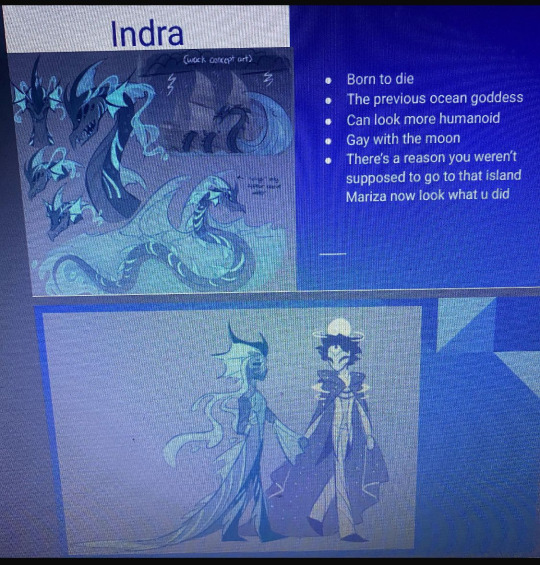
Above: Indra and Samira art by shandzii in the "Ocean Idiots for Idiots" slideshow by melodyofthevoid on pages 14-15
Transformed Mariza has the ability to transform from her serpentine form to a more humanoid form. Indra is capable of transforming from a entire sea-serpent to a more humanoid appearance. There happen to be plenty waterpeople who would be considered water snake-people like Mariza and Indra. Many of them live both in fresh- and saltwater, thus I will refer to such shrimply as watersnake-people. The closest counterpart to Mariza herself might be a tale of the Passamaquoddy Ne Hwas whose term which may be derived of "niwesq" solely means "spirit" for any supernatural being and it may tell of the Passamaquoddy and Malecite lumpeguin water-people instead. However, this folktale still tells of two freshwater-snake-maidens who once were mortal maidens. One day, they got cursed upon not heeding their mother's warning to not go into a lake at which moment they each possessed their lower halves of serpentine tails according to "The Penguin Book of Mermaids" on page 291. They would make that lake their habitat.
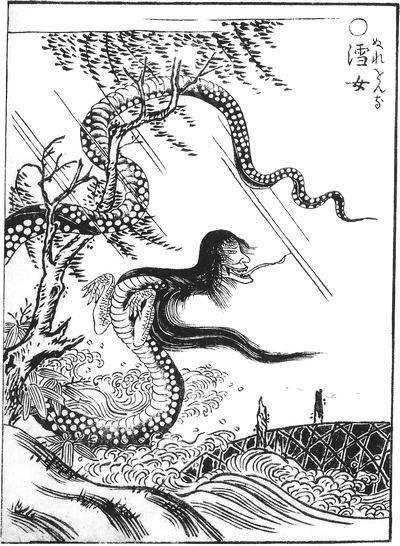
Above: "Nure-onna" by Toriyama Sekien 鳥山石燕 (1712-1788) in the Gazu Hyakki Yakō 画図百鬼夜行.
Some versions of the legend of freshwater-maiden Melusiné say that upon each Saturday, her lower body turned into a serpentine tail from a curse. Usually, she would possess the body of a mortal maiden on other days. There exist the female nagis or naginis and the male nagas in Hinduism who are described as shapeshifting waterfolk, capable of being watersnake-people. "Encyclopedia of Fairies in World Folklore and Mythology" by Theresa Bane on page 241 describes how they tend to "reside at the bottom of lakes, rivers, and the sea in gem encrusted palaces filled with never-ending dance and song". They are able to be partly or fully serpentine. A Russian folktale that is featured in "Russian Fairy Tales" by W. R. S. Ralston tells of complete freshwater-snakes who live underwater and are capable of turning into mortal people ashore. The Wabanaki and Passamaquoddy nodumkanwet or apodumken were waterpeople said to live in waters, possessing piscine or serpentine tails. In Passamaquoddy Bay, they may take the forms of gigantic, fanged water-serpents according to "Mythical Creatures of Maine: Fantastic Beasts from Legend and Folklore" by Christopher Packard on page 87. Nure-onna was a littoral watersnake-maiden from Japanese folklore, appearing as a watersnake with the head of a woman or a water snake-woman with the a humanoid upper body and the lower half of a serpentine tail. Jinja-hime from Japanese folklore was a sea-serpent with the head of a woman. Another Passamaquoddy myth with possible Christian influences according to "The Penguin Book of Mermaids" on page 289 told of two maidens who would go every Sunday to a lake to bathe and perform supposed ill-considered or undesirable acts which caused them to turn into human-headed freshwater-snakes forever. These are all only some finstances.
Mariza can shapeshift into an actual colossal sea serpent-person alongside as in the "Just a Thingy for School :P" animatic. Mariza seems to be capable of turning in tides back and forth from more averagely humanoid-sized to a more colossal sea serpent-person. This size-shifting is present in some folkloric waterpeople. According to "Mythical Creatures of Maine: Fantastic Beasts from Legend and Folklore" by Christopher Packard on page 85, the Native American Malecite and Passamaquoddy lumpeguin water-people could change their size in great amounts from as small to hide under a curled leaf to the size of a large man.
Both Indra and one of Mariza's forms have pointy head-fins which remind me of some ocean-people like the Orcadian sea-trows whose heads looked pointed like the roof of a house according to W. Traill Dennison in "Orkney Folklore: Sea Myths" in "The Scottish Antiquary, Or, Northern Notes & Queries, Volume 5" on page 167 and the Norse hafstramb merman whose head was described with the shape of a peaked helmet in the King's Mirror. Some native depictions of the Melanesian adaro from the Solomon islands in "The Melanesians: Studies in their Anthropology and Folklore" on pages 197 and 259 show the adaro with the head of a swordfish, including the dorsal fin showing from the head's tip.

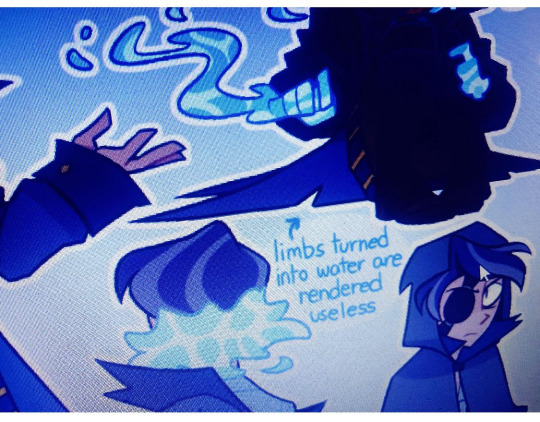
Above: Screenshots of Mariza art details by shandzii.
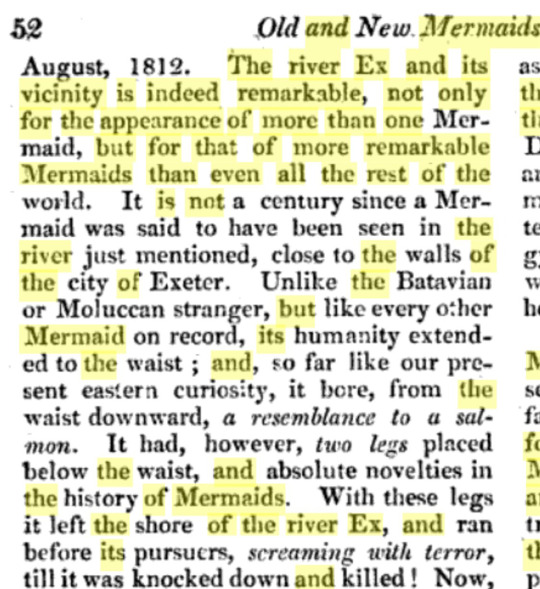
In regards to one of Mariza's usual forms where her legs would be present with a tail alongside, this reminds me of a description of a sighting from Exeter around the River Ex in ca. 1730-1750 as its distribution came from the August of 1823 in "The Asiatic Journal and Monthly Register for British India and its Dependencies Vol. XV" in an article called "Old and New Mermaids". Wherever or whomever this strange sighting originally stemmed from is unknown. "(...) It is not a century since a Mermaid was said to have been seen in the river just mentioned, close to the walls of the city of Exeter... Its humanity extended to the waist and.. it bore from the waist downwards a resemblance to a salmon. It had, however, two legs placed below the waist, and absolute novelties in the history of Mermaids. With these legs it left the shore of the river Ex (...)". Another earlier sighting in Exeter dated from the November of 1737 claimed how "some Fishermen near the city, drawing their Net ashore, a creature of two legs, having human shape, leapt out and ran away very swiftly. (...) Its feet were webbed like a duck’s. It has eyes, nose and mouth, resembling those of a man, only the nose somewhat depressed, and the tail not unlike a salmon’s, only turning up towards its back, and was four feet high". Also of note may be a depiction from the "Oedipus Aegypticus" by Athanisius Kirchner in 1652 of the Assyrian Atargartis aka. Derceto, a humanoid goddess who can be identified with a goddess at Ascalon who possessed piscine attributes.
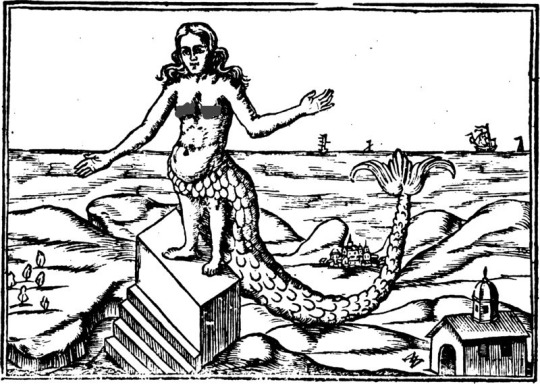
Above: Edited illustration from the "Oedipus Aegypticus" in 1652.
Mariza is also capable of having her limbs turn to an "useless" state of water according to one depiction. I find that this reminds me of the Greek myth of naiad or freshwater-nymph Cyane who was a friend of Persephone in some versions. According to one version, Cyane dissolved into liquid upon seeing Persephone being abducted by Hades. This motif seems somewhat similar to how Mariza may have similar situations where her limbs turn to water upon being distressed.
Indra and Mariza's ability to control the ocean is present in countless waterpeople like Poseidon or Neptune, Triton etc.....
Webbed fin ears themselves that many characters from this literary work bear have their own separate entry in my all-read sea, already. (I have read much in my sea already).
Well, Mariza's hair is also something to take a dive into. Perhaps it may show some similarities with the hair of Sedna in Inuit mythology since her hair was described as entangling the ocean's creatures if she was angry. Inuit shamans would comb her hair, for she herself had no fingers, so that the nautical creatures she withheld from being caught by the people could be free again. Her hair appears to be symbolic for the ocean itself as if her hair was really the ocean where the nautical creatures dwell according to "Orality and Literacy: Reflections Across Disciplines" by Susan Gingell on page 122 and "A Mermaid's Tale: A Personal Search for Love and Lore" by Amanda Adams on pages 129-130. This is somewhat similar to the watery hair motif.


Both Mariza and Delta happened to be pirate waterfolk. During my fin-itial research, the tides of time led me to an unknown legend of piratess Anne Bonny and how she supposedly turned into a mermaid. The legend is from Palma Ceia in Tampa, Florida's Gulf Coast. Mermaid Anne Bonny, wielding a sword, is depicted in the seal of the neighborhood on the left with a stingray-maid called Qualenya on the right. The second depiction of the solo Anne Bonny mermaid above is a bit edited, but this alongside the seal got published on Wikimedia Commons and on Flickr, all released as Public Domain. The description of the solo Anne Bonny depiction states how Anne Bonny, "the most fearsome of all sea hags first appeared in the winter of 1733, the same year Anne Bonny was tossed into the sea upon her conviction for piracy. They say that Anne made a deal with The Sailor’s Devil, that if she allowed him to marry her unborn daughter, he’d grant her eternal life beneath the sea. Ever since, all through the Caribbean and up the Florida coast, Bonny has been luring curious sailors to rocky shallows where their boats are crushed and sunk". Supposedly, what is related comes from a 1800s book on pirates, but its title is not stated in any tide of time which renders this source as rather unreliable, yet it may be a fin-teresting implication.

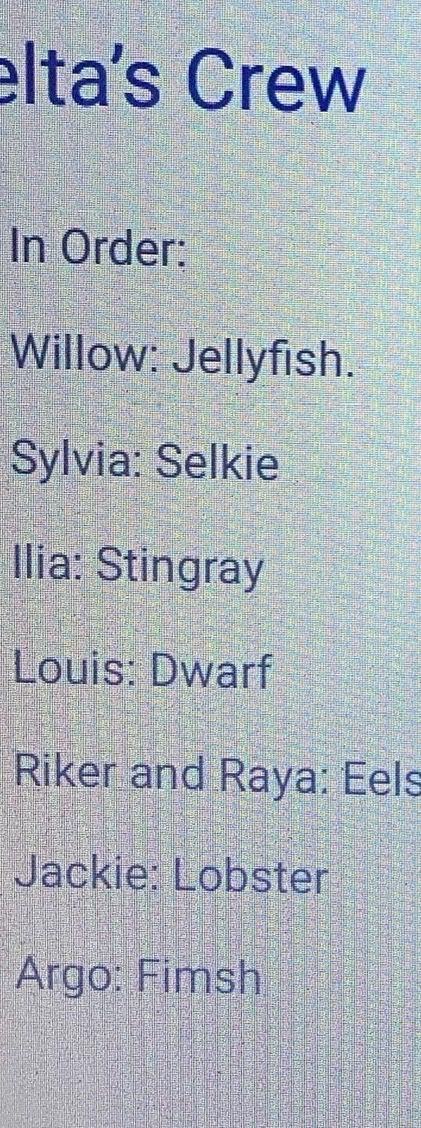
Above: Delta's crew and their respective species as in the "Ocean Idiots for Idiots" slideshow by melodyofthevoid on page 19.
I now shall dive into Delta's pirate crew. The most obvious is the selkie named Sylvia. Sealfolk are Celtic and Norse sea-people who wear sealskins, capable of being seals in the sea and shapeshifting ashore into their humanoid forms, being commonly known as selkies or roane. Without their sealskin, they would usually not be able to shapeshift back into seals and return to the sea.

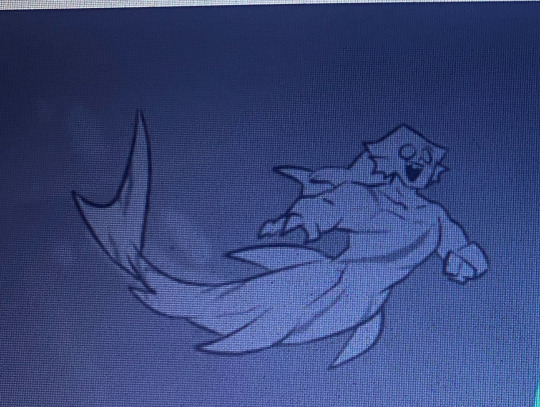
Above: Screenshots of the "She doesn't need Grass" animatic by shandzii.
Delta is capable of transforming into a shark-person. Many shark-people have existed. Dakuwaqa is a Fijian, shapeshifting oceanic deity who was said to be able to shapeshift into multiple forms like a shark or a humanoid. Avatea or Vatea of the mythology of the Cook islands could be a shark-man with his halves of humanoid and aquatic form being split vertically, but some claim he is half-fish or -porpoise alongside. Hawaiian mythology tells of demi-gods such as Nanaue who would be possessing a shark's mouth on their backs, capable of transforming into full shark forms. The Haida Dogfish-people, specifically the Dogfish-Woman, are shapeshifting dog-fish sharks who can assume mortal human forms ashore. Anyhow, Delta's aquatic form also possesses a head tapering into a shark's tail. This is something similar to what I have already done a dive into for the zora of "The Legend of Zelda" in a separate entry, but the Mesopotamian Abgal or Apkallu, sages who were said to have taught knowledge upon mortal humankind, one of the most well-known being named Uanna or Oannes, had such similar depictions with their heads tapering into fishtails. The Melanesian adaro do so alongside since their heads are literally swordfish in aforementioned depictions. Their heads taper into swordfish-tails. Delta's pectoral fins I assume also remind me of some depictions of supposed tritons or sea-satyrs who would have some front legs or fins, this is also something similar to one of Mariza's aforementioned forms.
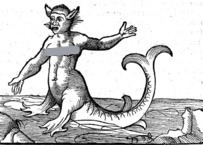
Above: Edited "Monstum Marinum" by Conrad Gessner from his "Historiae animalium" in 1558.

One of Delta's crew named Ilia is a stingray-person like Qualenya who may be from the mythology of the Seminole Native American people. My rather strange sources regarding her primarily fincluded Wikimedia Commons' descriptions for her depictions. Above is an illustration of a 1920s book, supposedly. She can apparently transform from a complete stingray to a more humanoid appearance upon being saved by a boy in a blogspot entry which is the only source I found about her legend, but the source is not reliable alongside. I wrote more about Qualenya in a earlier entry alongside with the Anne Bonny mermaid, consider diving into it.
Jackie from the crew is a lobster-person. Greek and Roman mythology may tell of humanoid sea-deities like tritons or ichthyocentaurs, Phorcys, and Pontus who could bear lobster claw appendages or lobster horns on their heads, possibly including spiky, reddish skin like those of lobsters in Hellenistic-Roman mosaics.

Above: Hellenistic-Roman mosaic of aforementioned lobster-people, photos by Dennis Javis, CC-BY SA 2.0.
Riker and Raya in Delta's crew are eel-people. The magindara of Filipino mythology known by the Bikolano community could be described with the tail of an eel or a snake according to Philip Hayward in "Scaled for Success: The Internationalisation of the Mermaid" on page 108.
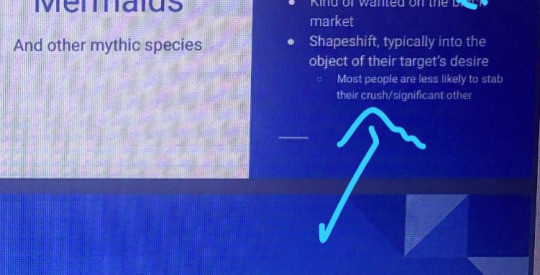
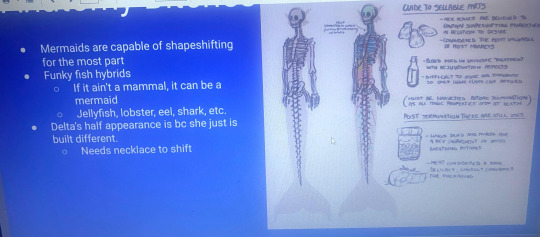
Above: Screenshots taken from the "Ocean Idiots for Idiots" slideshow by melodyofthevoid on pages 50-51.
Shapeshifting waterpeople are very common and numerous. The slideshow also claims that they require necklaces to shapeshift which is similar to the motif of many shapeshifting waterpeople requiring a talisman like the Irish merrows who require a certain hat called a cohuleen druith to do so. However, the theme of the necklace may be reminiscent to the kelpies of Scottish folklore, horses who live in aquatic environments and may assume humanoid form. A folktale from Barra in the Outer Hebrides related how a kelpie-man turned back into his equine form upon the removal of his necklace or bridle as a kelpie's shapeshifting ability was said to stem from its bridle. Some finstances in regards to how waterpeople may turn into objects as claimed in the slideshow, if I assume correctly, may be correspondent to the freshwater-poeple called the dracae from Scottish folklore or the dracs from French folklore who may assume humanoid form, but can also turn into anything their victim may desire like golden sundry and of course they may turn into wooden dishware even. I mean, who would not want wooden dishware?! It's so useful for many things.
Now, we shall dive into some more darker waters for a section, so please heed caution. It is quite the rough and stormy ocean fin terms of topics like cruelty, exploitation, dissection and some violence, especially since its tides stem from historical sources...

Above: Screenshots of "The Dismemberment Song" animatic by shandzii
Waterpeople, as claimed in the slideshow, are hunted by the forbidden market. Alleged historical records of waterpeople in regards to that show it in clear waters. Like Heather, so-called waterfolk hunters or butchers have already existed for long and I mean those who want to study or dissect them and so on and so forth. I do not refer to waterfolk-hunters who desperately want to sight and capture a waterperson upon being solely offered a reward, yet this motif may be somewhat similar to how Delta got captured in the first tide in "The Dismemberment Song" animatic with a Wanted Poster and a bounty possibly. Such "hunts" have been abundant, an official mermaid hunt was declared in Kiryat Yam in 2009 or another official one fin-cludes the mermaid hunt of the Isle of Man in 1961 according to "Merpeople: A Human History" by Vaughn Scribner on page 206. Fin such, usually a large sum of money would be declared even if one million, the price for the one who would be able to prove the existence of or capture the waterperson. Many assume such hunts solely have their origins in the means of tourist attraction. According to "Merpeople: A Human History" by Vaughn Scribner on page 105, in the year of 1749, Carl Linnaeus had read newspaper articles of waterfolk sightings from Nyköping in Sweden and sent a letter to the Swedish Academy of Science. He wanted to declare a hunt to "catch this animal alive or in spirits" for "in his mind, the reward outweighed the risk, as the discovery of such a rare phenomenon 'could result in one of the biggest discoveries that the Academy could possibly achieve and for which the whole world should thank the Academy'. Perhaps these creatures could reveal humankind's origins?". A mile off Exmouth in the 13th August of 1812, the certain Mr. Toupin and his crew sighted a supposed mermaid. It was said that "(..) a medical gentleman of Exeter has offered a reward of 20 pounds to whoever may succeed in catching the animal, and will bring it to him for dissection. In consequence of this, all the fishermen are very busy in making preparations to endeavour to entangle in their nets this fair nymph of the ocean". Whether this actually happened is a mystery. However, in the aforementioned sightings of legged waterpeople in Exeter, some sighted waterpeople would be hunted or at least chased until they would be dead and their corpse would be exploited.

In regards to Heather, I specifically refer to certain fin-atics who want to dissect or capture waterpeople in a more "professional" tide by making profit of any sort from them. The waterpeople in this work are hunted fin order for the parts of theirs to be sold on the forbidden market for all the supposed healing or magical properties they are said to have, which I fin-d is somewhat similar to the Japanese folktales of the ningyo 人魚 who had been hunted by mortal people for their healing properties. The flesh of the ningyo was said to cause youth and immortality. Ningyo blood was said to heal any wound according to "Encyclopedia of Fairies in World Folklore and Mythology" by Theresa Bane on page 249. The waterpeople in this literary work share almost the same properties of ningyo. Hoax ningyo specimens like Feeje mermaids were originally also manufactured by the Japanese and are still attributed with healing properties, despite only being usually sewn together with the top half of a monkey and the lower half of a fish. Ningyo bones are described to possess healing properties such as prevention from getting sick, stopping bloody bowel discharges as it's claimed in the "Bencao gangmu" from the 16th century, the "Compendium of Materia Medica", or such bones being used as an antidote in the Netherlands as it's said in the "Wakan sansai zue" in 1713. In the 14th April of 1222, a supposed ningyo washed up on Hakata Bay on the island of Kyushu. It was declared that the ningyo was a good omen and the bones of the alleged ningyo corpse were buried at the Ukimido temple. Around the Edo period, the bones were unearthed and soaked into the waters of the temple where bathers could absorb the supposed healing properties of sickness prevention. Scholars from the Edo period would also consume powdered ningyo bones, thinking it would extend their lives. A recorded fin-stance from 1906 told of the certain Rosa Stanley who charged Mrs. Merrit of Mulberry in Indiana large sum of money for some mermaid skin that could supposedly heal the cancer of hers. It turned into a fin-teresting situation with court dealings which one shall read in the source I shall provide in a separate entry. Skins of waterpeople are also used for many other things. According to "Legends and Superstitions of the Sea and Sailors" by Fletscher S. Bassett on page 169, "(Petrus) Gyllius says the skin of sea men taken in Dalmatia is so though that it is used for saddle covers".
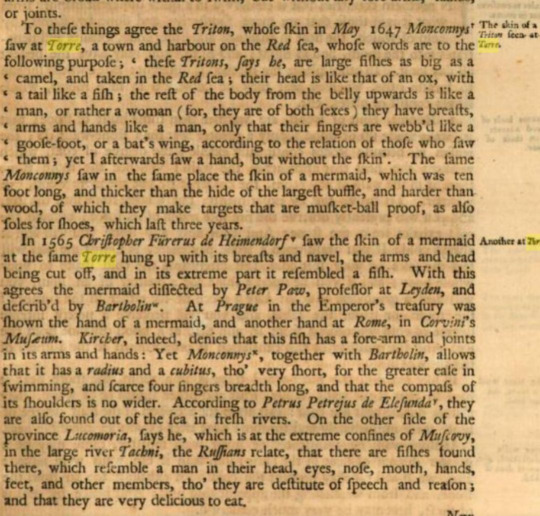
Another account which tells how the town of Torre at the Red Sea would use mermaid skin for shoe soles or targets "that are musket-ball proof" stems from "Acta Germanica; or, The Literary memoirs of Germany" on page 171. "The Triton, whose skin in May 1647 Monconnys saw at Torre, a town and harbour on the Red sea, whose words are to the following purpose; ‘these Tritons, says he, are large fishes as big as a camel and taken in the Red sea (...). The same Monconnys saw in the same place the skin of a mermaid, which was ten foot long, and thicker than the hide of the largest buffle, and harder than wood, of which they make targets that are musket-ball proof, as also soles for shoes, which last three years". The so-called Petrus Petrejus de Elesunda also mentioned in the account how in the province Lucomoria at the extreme confines of Muscovy, there are freshwater-people who are "very delicious to eat". This alongside shows how the ningyo were also prepared as dishes which corresponds to how the flesh of the waterfolk in this literary work, as claimed in the slideshow, is a "rare delicacy".
Now, I dive into the dissections of waterfolk. Aside from all those hoaxes of supposed specimens of waterpeople like the Feeje mermaids who have been dissected, some sea-cretive ones persist. A fin-stance stems from the year of 1560 in which some fishermen once caught seven mermen fincluding mermaids "on the western coast of the island of Ceylon", off the southeast tip of India according to "Merpeople: A Human History" by Vaughn Scribner on page 66. Some Jesuit priests and some certain "F. Hen. Henriques, and Dimas Bosquez physicians to the viceroy of Goa" were some trustworthy witnesses, apparently. Those physicians examined the merpeople "with a great deal of care, and made dissection thereof". Supposedly, "all the parts of both internal and external were found perfectly conformable to those of men".
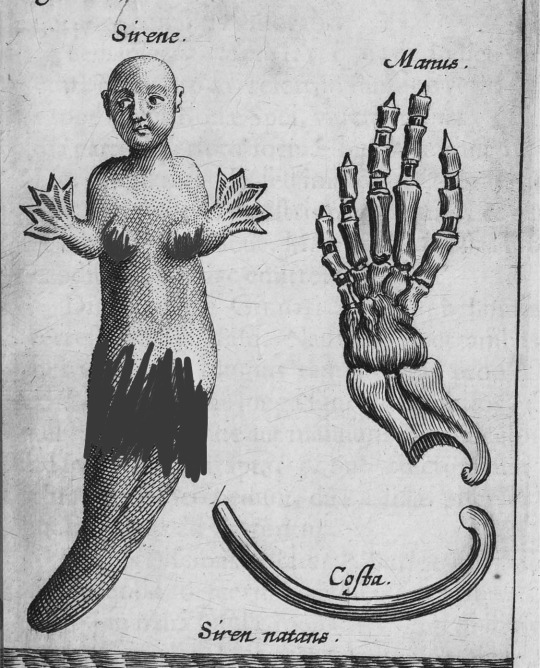
Above: Edited illustration in "Historiarum anatomicarum rariorum" in 1654.
Heather also kept a waterperson in a tank in the Animal Cann!bal animatic which is a similar motif found in the mermaid of Amboina sighting. Samuel Fallours claimed that he "had this Syrene alive for four days in (his) house at Ambon in a tub of water" according to Vaughn Scribner's work on page 106. Heather is in the possession of many waterfolk parts and puts these on display in a private collection. Vaughn Scribner tells in his "Merpeople: A Human History" on page 79 that "these were not the full, intact and scientifically studied creatures that their eighteenth and nineteenth century successors boasted. Nevertheless, by the end of the seventeenth century, mermaid hands, skins and occasionally full specimens became popular features of private collections and public exhibits". On page 80, he claims that "private collectors, (...), spent the seventeenth century scouring the globe for physical mer-specimens". As an example, in 1638, John Tradescant had "the hand of a mermaid" in his private museum in London. Thomas Bartholin held a supposed skeleton hand and the rib bones of a mermaid in his collection while he also claimed to have dissected a mermaid in Leiden which he featured in his "Historiarum anatomicarum rariorum" in 1654.
"Acta Germanica; or, The Literary memoirs of Germany" on page 171 asserts that "at Prague in the Emperor's Treasury was shown the hand of a mermaid, and another hand in Rome, in Corvini's museum". According to Vaughn Scribner's work on pages 81-82, the Royal Society of London's member Nehemiah Grew recorded in the "Catalogue & Description of the Natural and Artificial Rarities Belonging to the Royal Society and Preserved at Gresham College" in chapter one "the Rib of A Triton or Mareman. About the same length with that of a Mans, but thicker and stronger; and nothing near so much bended. (...) A Bone said to be taken out of a Maremaids Head. It is in bigness and shape not much unlike that called Lapis Manati, but the knobs and hollows thereof are somewhat different".

Above: Illustration from "The Life of P. T. Barnum" on page 233 in 1855.
Entire displayed waterfolk specimens like those that Heather had alongside are plenty as hoaxes like the Feeje mermaids or possible cases of sirenomelia. Many would purchase such faked specimens of waterpeople and, for finstance, display them and charge for money if one wanted to sea the supposed specimen. Such also happened to be exhibited of-fish-ially in museums. As related by Vaughn Scribner in pages 137-138 in his work, an infamous case was of Captain Eades' mermaid who lured with her siren song audiences of London in 1822. While he was in Batavia, the Dutch East Indies, during a trade deal, he was captivated by a dried mermaid so much so that he sold his entire ship and its contents. He believed the hoax that some Japanese fishermen had caught that mermaid, but yet his mermaid did become fin-famous in London, so it may have paid off. In spite of that, some supposed specimens are still mysteries. The sighted waterperson of Exeter in the November of 1737 who had been eliminated was also put on display in Exeter and then in London, but not a fellow has any idea whether it actually happened. The beheaded Tanagran triton in Greek mythology was also said to have been beheaded and displayed in the town of Tanagra. These are all just some fin-stances.

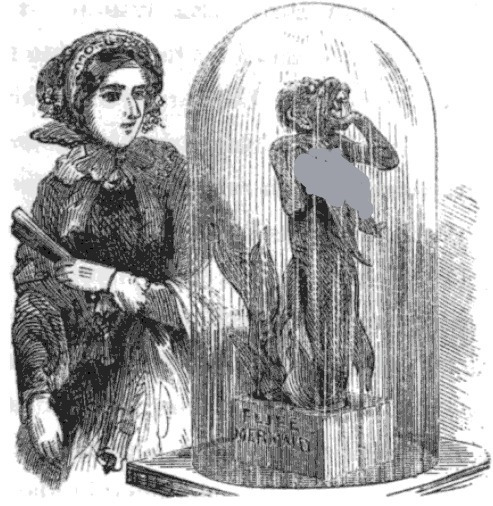
On the left above: Gif by shandzii in "The Dismemberment Song" animatic and on the right above: Edited illustration from "Sights in Boston and Suburbs, or Guide to the Stranger" in 1857.
Some claim to have purchased living waterpeople. Samuel Fallours' son had purchased the mermaid and brought it to him from the nearby island of Buru for "two ells of cloth" according to Vaughn Scribner's retelling in his work on the same aforementioned page.
Mariza encounters a lunar deity named Samira in the "Ship in a Bottle" animatic. Samira also was in a relationship with the previous oceanic deity Indra according to the slideshow. This may fin-dicate waterfolk's connection to the moon, especially lunar cycles since the moon fin-fluences the tides of the oceans and thus all marine life. Many waterpeople have more direct connections to the moon such some seal-people who could often only appear during nights such as when a full moon was present. Atargartis aka. Derceto is also said to be a goddess of the moon. Avatea or Vatea's eyes were also said to represent the sun and the moon.

Resonates with me in some tide. Screenshot taken from the "Ocean Idiots for Idiots" slideshow by melodyofthevoid on page 56.
Mariza is the humanoid oceanic deity in contrast to Larus who is the aerial deity as an avian humanoid. They are described as "siblings", but this is not in the literal sense. Larus only considers Mariza a sister. This connection, yet parallel between the aerial avian and the aquatic piscine can be somewhat distinguished in the Abgal or Apkallu. They could either appear with piscine or avian attributes, thus be considered as piscine and or either avian humanoids. The seirenes of Greek mythology would also be a well example for they were once considered to be avian humanoids and later on piscine through many shifts, especially when they were reinterpreted by Christianity. While these possible water-people that I mentioned are seen as being both at the same time´throughout history by having their names attributed to both the avian and the piscine, still and all, the direct comparison or distinction between the aerial and the aquatic in humanoid beings, the avian and the piscine, thus is an ancient concept, despite all of them not being separate deities directly like it is shown between Mariza and Larus. Atargatis or Derceto may be of mention alongside since one of her symbols was said to be the dove. In the general tide, this distinction shows the duality of air and water.
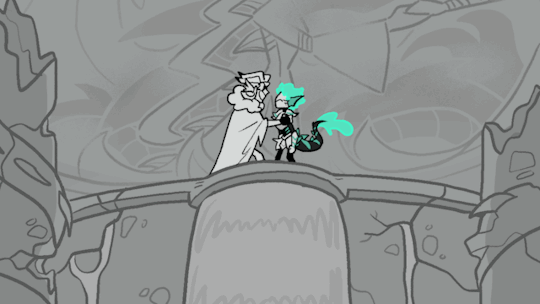

On the left above: GIF from the "It's Tough to be A God" animatic by shandzii and on the right above: Screenshot of an answered ask request on shandzii's tumblr.
All digital sources will be separate in a reblog of mine of this entry since I feel like it could be fine to be separate for this entry.
Thanks for diving into my sea alongside :>
Edits: Changed in the first phrases "well-known" to " popular"*
#ocean idiots#mariza#merfolk#merpeople#shandzii#larus#delta#waterfolkology#literary waterfolkology#mermaid#mermaids#merman#mermen#mythology#folklore#one cannot fathom how much i liked to dive finto this#i wish-fished to finclude more puns but it would get overflooded#i needs to balance the aquatic puns... blubb
9 notes
·
View notes
Photo

The calm before the storm #swimmer #swimming #swimmingpool #swimlife #swimteam #swimpractice #swimswam #poolporn #waterpeople #chlorineismyperfume #mermaidatheart
#swimteam#swimming#swimpractice#poolporn#mermaidatheart#swimlife#swimmer#chlorineismyperfume#waterpeople#swimmingpool#swimswam
1 note
·
View note